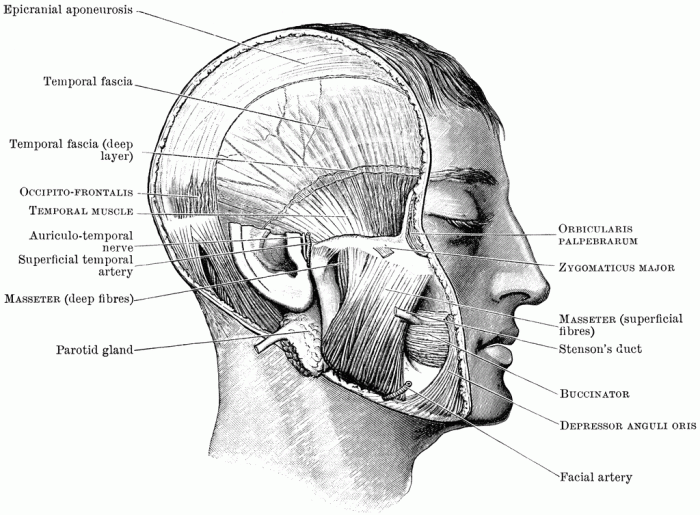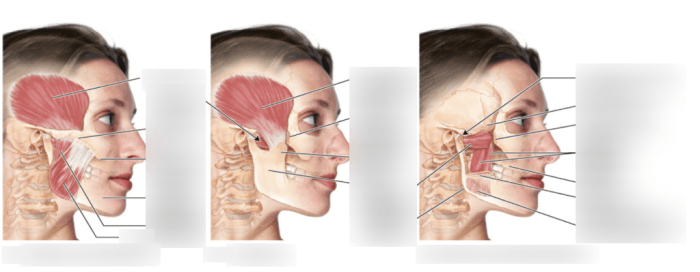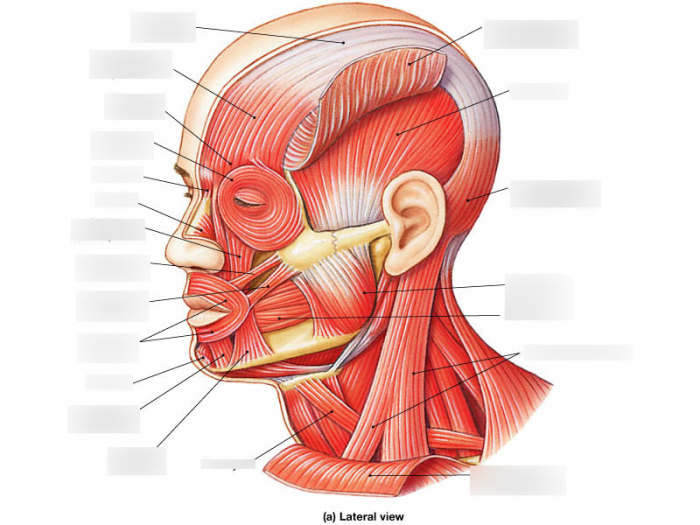Label the muscles of expression and mastication – Delving into the intricacies of facial expressions and mastication, this comprehensive guide explores the muscles responsible for these vital functions. Understanding their anatomy, innervation, and actions is crucial for comprehending the complex interplay of facial movements and chewing mechanisms.
This guide meticulously examines the muscles of expression, unraveling their intricate interplay in conveying emotions and facilitating nonverbal communication. It delves into the muscles of mastication, illuminating their role in the essential process of chewing, breaking down food for digestion.
Muscles of Expression

The muscles of expression are responsible for the wide range of facial expressions that humans can produce. These muscles are located in the face and are innervated by the facial nerve (cranial nerve VII).
The following table lists the muscles of expression, their innervation, and their actions:
| Muscle | Innervation | Action |
|---|---|---|
| Frontalis | Facial nerve | Raises the eyebrows |
| Orbicularis oculi | Facial nerve | Closes the eyelids |
| Corrugator supercilii | Facial nerve | Draws the eyebrows together |
| Procerus | Facial nerve | Draws the eyebrows together and wrinkles the skin of the forehead |
| Nasalis | Facial nerve | Wrinkles the skin of the nose |
| Depressor septi nasi | Facial nerve | Lowers the nasal septum |
| Depressor anguli oris | Facial nerve | Lowers the corners of the mouth |
| Orbicularis oris | Facial nerve | Closes the lips |
| Buccinator | Facial nerve | Compresses the cheek against the teeth |
| Risorius | Facial nerve | Draws the corners of the mouth laterally |
| Zygomaticus major | Facial nerve | Raises the corners of the mouth |
| Zygomaticus minor | Facial nerve | Raises the corners of the mouth |
| Levator labii superioris | Facial nerve | Raises the upper lip |
| Levator labii superioris alaeque nasi | Facial nerve | Raises the upper lip and widens the nostrils |
| Levator anguli oris | Facial nerve | Raises the corners of the mouth |
Muscles of Mastication: Label The Muscles Of Expression And Mastication

The muscles of mastication are responsible for chewing. These muscles are located in the head and are innervated by the trigeminal nerve (cranial nerve V).
The following table lists the muscles of mastication, their innervation, and their actions:
| Muscle | Innervation | Action |
|---|---|---|
| Temporalis | Trigeminal nerve | Elevates the mandible |
| Masseter | Trigeminal nerve | Elevates the mandible |
| Medial pterygoid | Trigeminal nerve | Elevates the mandible and moves it forward |
| Lateral pterygoid | Trigeminal nerve | Moves the mandible laterally |
Innervation of the Muscles of Expression and Mastication

The muscles of expression and mastication are innervated by the facial nerve (cranial nerve VII) and the trigeminal nerve (cranial nerve V), respectively.
The following diagram illustrates the innervation of these muscles:
Clinical Significance

Understanding the muscles of expression and mastication is important for a variety of reasons. For example, these muscles can be affected by facial paralysis, which can result in difficulty with facial expressions and speech. Additionally, these muscles can be involved in temporomandibular joint (TMJ) disorders, which can cause pain and difficulty with chewing.
Case studies or examples:
- A patient with facial paralysis may have difficulty smiling or raising their eyebrows.
- A patient with TMJ disorder may have pain and difficulty chewing.
FAQ Insights
What are the primary muscles involved in smiling?
The primary muscles involved in smiling are the zygomaticus major and minor, which elevate the corners of the mouth.
Which muscle is responsible for frowning?
The corrugator supercilii muscle is responsible for frowning, drawing the eyebrows together and creating vertical wrinkles on the forehead.
What is the strongest muscle involved in chewing?
The masseter muscle is the strongest muscle involved in chewing, responsible for elevating the mandible (lower jaw).